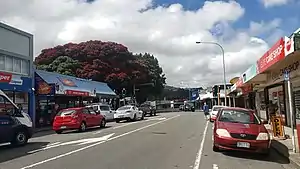Alicetown | |
|---|---|
 The main shopping area in Alicetown | |
| Coordinates: 41°12′59″S 174°53′27″E / 41.21639°S 174.89083°E | |
| Country | New Zealand |
| City | Lower Hutt City |
| Electoral ward | Western |
| Established | 1900s |
| Area | |
| • Land | 126 ha (311 acres) |
| Population (June 2023)[2] | |
| • Total | 3,000 |
| Train stations | Western Hutt Station, Melling Line. Ava railway station, Hutt Valley Line. |
| Maungaraki | Normandale | Melling |
|
|
Lower Hutt CBD | |
| Petone | Ava | Woburn |
Alicetown is a central suburb of Lower Hutt located at the bottom of the North Island of New Zealand.
The suburb is situated north of the major suburb of Petone and west of the Lower Hutt CBD. Its boundaries are the Ewen Bridge that crosses the Hutt River, New Zealand to the east, the Western Hutt Rd/Melling Railway track to the west, Wakefield St/Hutt Railway track to the south and Railway Ave to the north.
History and culture
Aglionby, on what is now Tama Street, became the first European settlement in the Hutt Valley in 1840. The Aglionby Arms, the valley's first hotel, was built in Alicetown in 1840 and relocated in 1847.[3] Alicetown began as a farming settlement and was settled from the early 1900s by Petone factory workers.[4]
Alicetown was named for Alice Maud Fitzherbert, the daughter of mayor William Fitzherbert who married Professor George William von Zedlitz in 1905.[5]
Te Tatau o Te Pō Marae was established in Alicetown in 1933. It is a marae (tribal meeting ground) of Taranaki Whānui ki te Upoko o te Ika and Te Āti Awa and includes Te Tatau o Te Pō wharenui (meeting house).[6][7]
Demographics
Alicetown-Melling statistical area covers 1.26 km2 (0.49 sq mi),[1] including Melling. It had an estimated population of 3,000 as of June 2023,[2] with a population density of 2,381 people per km2.
| Year | Pop. | ±% p.a. |
|---|---|---|
| 2006 | 2,535 | — |
| 2013 | 2,700 | +0.90% |
| 2018 | 2,793 | +0.68% |
| Source: [8] | ||
Alicetown-Melling had a population of 2,793 at the 2018 New Zealand census, an increase of 93 people (3.4%) since the 2013 census, and an increase of 258 people (10.2%) since the 2006 census. There were 1,056 households, comprising 1,422 males and 1,368 females, giving a sex ratio of 1.04 males per female. The median age was 35.8 years (compared with 37.4 years nationally), with 510 people (18.3%) aged under 15 years, 609 (21.8%) aged 15 to 29, 1,416 (50.7%) aged 30 to 64, and 255 (9.1%) aged 65 or older.
Ethnicities were 67.2% European/Pākehā, 11.6% Māori, 6.9% Pasifika, 22.4% Asian, and 2.4% other ethnicities. People may identify with more than one ethnicity.
The percentage of people born overseas was 29.5, compared with 27.1% nationally.
Although some people chose not to answer the census's question about religious affiliation, 47.3% had no religion, 33.0% were Christian, 0.6% had Māori religious beliefs, 7.7% were Hindu, 0.9% were Muslim, 1.8% were Buddhist and 3.1% had other religions.
Of those at least 15 years old, 687 (30.1%) people had a bachelor's or higher degree, and 306 (13.4%) people had no formal qualifications. The median income was $40,300, compared with $31,800 nationally. 552 people (24.2%) earned over $70,000 compared to 17.2% nationally. The employment status of those at least 15 was that 1,362 (59.7%) people were employed full-time, 303 (13.3%) were part-time, and 87 (3.8%) were unemployed.[8]
Education
Alicetown has two schools:
- Hutt Central School is a state contributing primary (Year 1–6) school in northern Alicetown, and has 296 students as of April 2023.[9]
- Te Kura Kaupapa Māori o Te Ara Whanui is a state Māori-immersion full primary (Year 1–8) school in Victoria Street, southern Alicetown, and has 367 students as of April 2023.[9]
The nearest state intermediate (Year 7–8) school is Hutt Intermediate School, and the nearest state secondary (Year 9–13) school is Hutt Valley High School, both across the Hutt River in neighbouring Woburn.
References
- 1 2 "ArcGIS Web Application". statsnz.maps.arcgis.com. Retrieved 10 June 2021.
- 1 2 "Population estimate tables - NZ.Stat". Statistics New Zealand. Retrieved 25 October 2023.
- ↑ Hutt City Libraries - How the Hutt got its name. Retrieved: 7 December 2017
- ↑ Te Ara: The Encyclopaedia of New Zealand - Hutt Valley - south Retrieved: 13 January 2009
- ↑ Kaye, George (1987). Bygone Days in Lower Hutt. Lower Hutt: Lower Hutt City Council. pp. 116, 117. ISBN 0-473-00523-9.
- ↑ "Te Kāhui Māngai directory". tkm.govt.nz. Te Puni Kōkiri.
- ↑ "Māori Maps". maorimaps.com. Te Potiki National Trust.
- 1 2 "Statistical area 1 dataset for 2018 Census". Statistics New Zealand. March 2020. Alicetown-Melling (244000). 2018 Census place summary: Alicetown-Melling
- 1 2 "New Zealand Schools Directory". New Zealand Ministry of Education. Retrieved 12 December 2022.